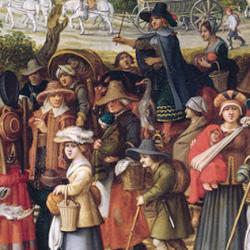Leave aside the question of illegal immigrants for a moment. Legal immigration is itself a political and cultural challenge. And one of the central questions is whether or not the newest immigrants – coming from Latin America, Africa, and Asia rather than from Europe – can assimilate to American life. Can they become Americans?
In their study of Religion and the New Immigrants, Michael Foley and Dean Hoge observe that the answer to the question about whether immigrants are assimilating to the American Way of Life depends on what we think they should assimilate to.
They see plenty of signs that immigrants are becoming good consumers and producers: “If Americanness is defined in terms of consumer values, then the evidence seems clear that most immigrants have assimilated. While many cling to the foods of their native lands (to the extent that they can acquire them), most have eagerly adopted American eating habits to one degree or another, certainly by the second generation, with all the deleterious health consequences that entails. Any stroll through a Wal-Mart or Target can confirm that immigrants contribute their share to the growing national appetite for the appliances and appurtenances that fill the American household. . . .In terms of employment, important segments of the new immigrants have been integrated into professional and technical positions, particularly in the new information technology economy— a sharp contrast with the overwhelmingly working-class first-generation immigrants of a hundred years ago. The majority, whether professionals, selfemployed, or working-class, have sought out and found employment niches that are vital to the growing U.S. economy, as have immigrants throughout our history” (7-8).
Other measures also indicate that they are assimilating: “even in Hispanic enclaves like Miami, immigrant youth and the second generation in general achieve English fluency faster than was the case in the past, thanks perhaps to the pervasive influence of American television both here and abroad” (8). Many come to the US with the intention of returning home, but over time that fades and they begin to regard the US as their home.
Foley and Hoge wonder, though, how far we want immigrants to assimilate to our ways: “the ‘values’ to which immigrant parents frequently object are materialism, selfishness, disrespect for elders, and laziness” (8).
That is snarky, but the point is worth making. We could do with a healthy dose of non-assimilation in those areas. Perhaps non-assimilation is a blessing.











